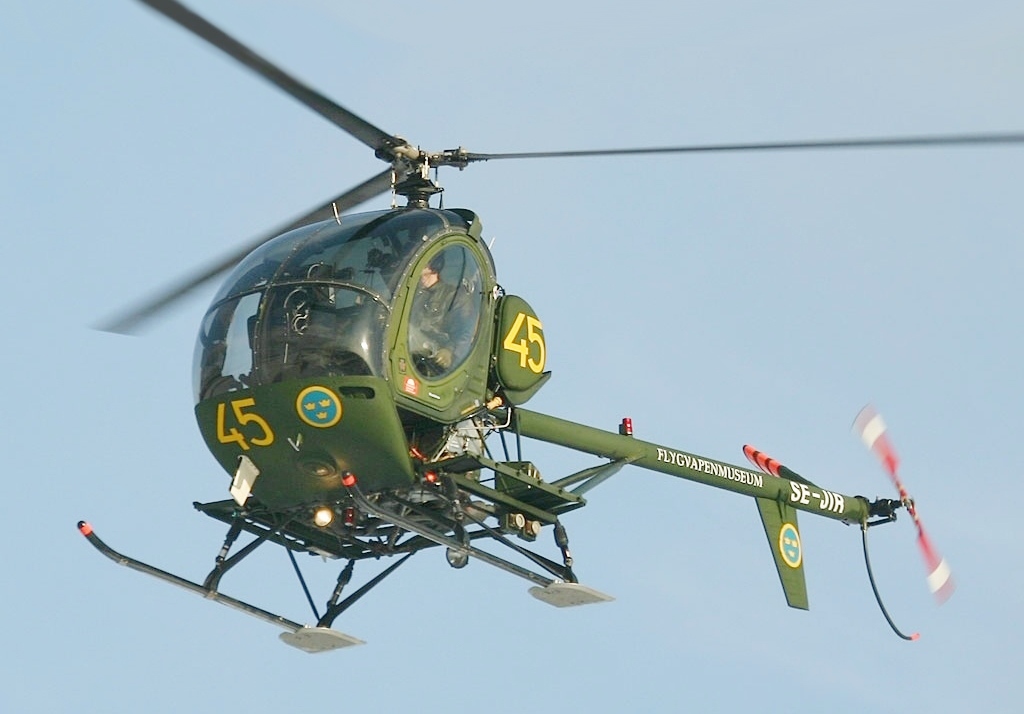Hkp 5 – The flying pencil sharpener
Swedish Army Aviation first made acquaintance with the Hughes 269 back in 1964 when two of them were acquired as comparative machines before testing of the Fpl 51 Super Cub aircraft in the role of artillery spotting. These helicopters received the designation Hkp 5A. A helicopter could get to an artillery observation location from a hiding place faster than than an aircraft, although it made a louder sound. The idea of having artillery spotting aircraft was in the case of war to ”call up” or requisition small civilian aircraft of that type. However at that time there were too few civilian helicopters available to be called up if hostilities began, while access to such civilian aircraft as the Super Cub was much better.
The two helicopters that had been acquired eventually crashed, leaving a mixed impression behind. Their operatng costs were double those of aircraft; they could only carry a smaller load and had a limited range. A saying about the Hkp 5A was for example ”Fuel at minimum already at take-off” and that it was more or less standard procedure to carry a spare can of fuel. Its aurorotation characterisrics were not the best, either. Autorotation is the technique necessary if lack of engine power forces an emergency landing. The airflow keeps the main rotor turning during the descent so that it acts as a kind of parachute for the helicopter. One pilot described the Hkp 5 as having similar autorotation characteristics to a piano!
The story of the Hkp 5A ended after both the helicopters crashed, the first in 1967 and the other in 1971. One of these accidents took place during practising an autorotation as described above. This could have spelt the end of the Hkp 5’s Swedish career, but fate determined otherwise.

An Hkp 5 in Swedish Army Aviation colours. This one now belongs Swedish Air Force Museum. Source: Wikimedia.
The Hkp 5B makes an entrance
However the story did not end there. A discussion arose at the end of the 1970s in the Swedish Army Helicopter training school about the need for a training helicopter. At this time the Army had replaced its old Hkp 2s and the leased Bell 47s used for training by the Hkp 6A. However this had disadvantages. The Hkp 6 was considered to be receiving too much of a battering in the hands of students, and in any case was too expensive to operate as an instructional machine. Older, experienced helicopter pilots also remarked ”Anyone who can’t fly a Bell 47, can’t fly a helicopter!”
The truth of this last statement is debatable, but the discussion ended with agreement that there was a need for a specialised training helicopter, that would not be particulary powerful and that would have manual controls.
Between 1980 and 1981 testing took place on three leased machines at AF 1, Boden. The fiercely cold winter in Norrbotten caused some problems on keeping the engines warm, but in general all was well, and in 1982 Army Aviation received more type Hkp 5B helicopters.
It was the SAAB company, via the SAAB Helicopter Division AB (SHAB) that built the helicopters under licence, and the first three to be delivered were painted in either blue, yellow or red.
The Hkp 5B would serve as a training and observation helicopter for Swedish Army Aviation until 1998, at which time major changes would take place. All helicopter operations in the Swedish Defence Forces were combined in a group known at the Helicopter Fleet, which led to the Army and Navy Aviation in Sweden disappearing as separate entities. 25 Hkp 5B helicopters were transferred to the new organisation and from then on were used mainly for introductory training of helicopter pilots until 2002 when the Hkp 5s were finally disposed of as military machines.
